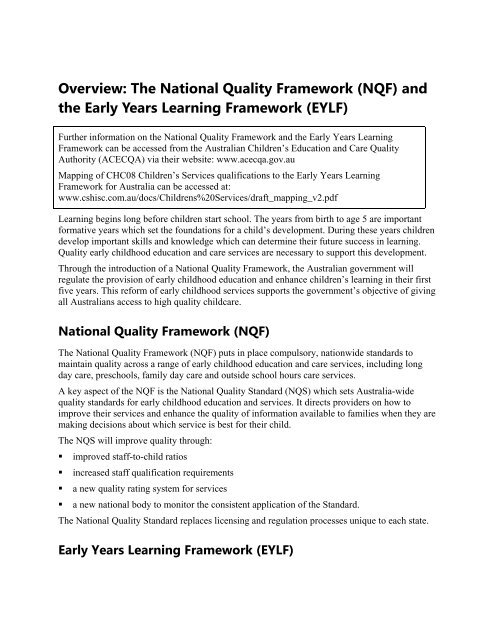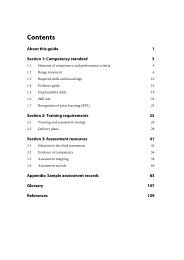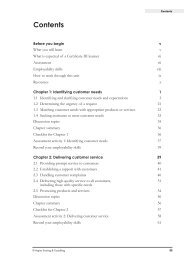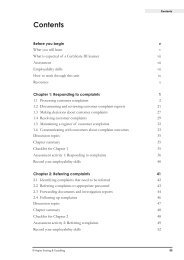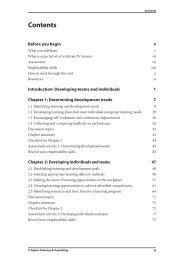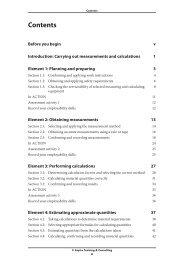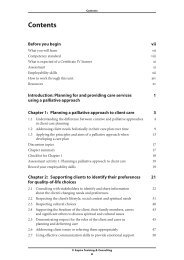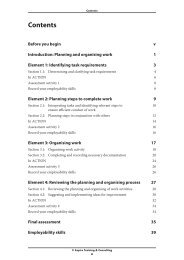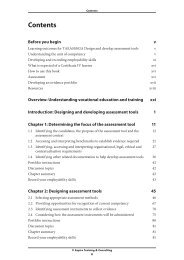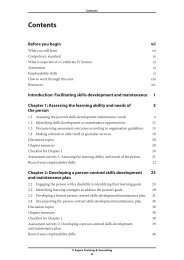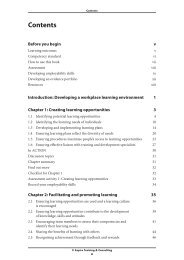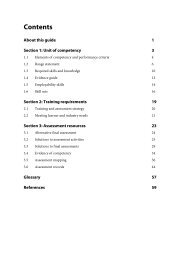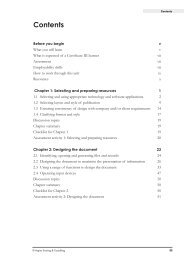(NQF) and the Early Years Learning Framework (EYLF)
(NQF) and the Early Years Learning Framework (EYLF)
(NQF) and the Early Years Learning Framework (EYLF)
Create successful ePaper yourself
Turn your PDF publications into a flip-book with our unique Google optimized e-Paper software.
Overview: The National Quality <strong>Framework</strong> (<strong>NQF</strong>) <strong>and</strong><strong>the</strong> <strong>Early</strong> <strong>Years</strong> <strong>Learning</strong> <strong>Framework</strong> (<strong>EYLF</strong>)Fur<strong>the</strong>r information on <strong>the</strong> National Quality <strong>Framework</strong> <strong>and</strong> <strong>the</strong> <strong>Early</strong> <strong>Years</strong> <strong>Learning</strong><strong>Framework</strong> can be accessed from <strong>the</strong> Australian Children’s Education <strong>and</strong> Care QualityAuthority (ACECQA) via <strong>the</strong>ir website: www.acecqa.gov.auMapping of CHC08 Children’s Services qualifications to <strong>the</strong> <strong>Early</strong> <strong>Years</strong> <strong>Learning</strong><strong>Framework</strong> for Australia can be accessed at:www.cshisc.com.au/docs/Childrens%20Services/draft_mapping_v2.pdf<strong>Learning</strong> begins long before children start school. The years from birth to age 5 are importantformative years which set <strong>the</strong> foundations for a child’s development. During <strong>the</strong>se years childrendevelop important skills <strong>and</strong> knowledge which can determine <strong>the</strong>ir future success in learning.Quality early childhood education <strong>and</strong> care services are necessary to support this development.Through <strong>the</strong> introduction of a National Quality <strong>Framework</strong>, <strong>the</strong> Australian government willregulate <strong>the</strong> provision of early childhood education <strong>and</strong> enhance children’s learning in <strong>the</strong>ir firstfive years. This reform of early childhood services supports <strong>the</strong> government’s objective of givingall Australians access to high quality childcare.National Quality <strong>Framework</strong> (<strong>NQF</strong>)The National Quality <strong>Framework</strong> (<strong>NQF</strong>) puts in place compulsory, nationwide st<strong>and</strong>ards tomaintain quality across a range of early childhood education <strong>and</strong> care services, including longday care, preschools, family day care <strong>and</strong> outside school hours care services.A key aspect of <strong>the</strong> <strong>NQF</strong> is <strong>the</strong> National Quality St<strong>and</strong>ard (NQS) which sets Australia-widequality st<strong>and</strong>ards for early childhood education <strong>and</strong> services. It directs providers on how toimprove <strong>the</strong>ir services <strong>and</strong> enhance <strong>the</strong> quality of information available to families when <strong>the</strong>y aremaking decisions about which service is best for <strong>the</strong>ir child.The NQS will improve quality through:• improved staff-to-child ratios• increased staff qualification requirements• a new quality rating system for services• a new national body to monitor <strong>the</strong> consistent application of <strong>the</strong> St<strong>and</strong>ard.The National Quality St<strong>and</strong>ard replaces licensing <strong>and</strong> regulation processes unique to each state.<strong>Early</strong> <strong>Years</strong> <strong>Learning</strong> <strong>Framework</strong> (<strong>EYLF</strong>)
The <strong>Early</strong> <strong>Years</strong> <strong>Learning</strong> <strong>Framework</strong> (<strong>EYLF</strong>) is ano<strong>the</strong>r component of <strong>the</strong> <strong>NQF</strong>. Developedthrough consultation with experts in <strong>the</strong> field, <strong>the</strong> <strong>EYLF</strong> is Australia’s first national curriculumframework for early childhood education. It emphasises play-based activities to enhance earlylearning <strong>and</strong> <strong>the</strong> importance of communication <strong>and</strong> language (including early literacy <strong>and</strong>numeracy). The <strong>EYLF</strong> covers <strong>the</strong> childhood years up to transition into primary school.The <strong>EYLF</strong> is a m<strong>and</strong>atory component of <strong>the</strong> NQS <strong>and</strong> providers will need to show evidence of<strong>the</strong> <strong>EYLF</strong> in <strong>the</strong> delivery of <strong>the</strong>ir programs. An Educators’ Guide to <strong>the</strong> <strong>Early</strong> <strong>Years</strong> <strong>Learning</strong><strong>Framework</strong> is available to assist educators in implementing <strong>the</strong> <strong>Framework</strong>.Each childcare provider will need to familiarise <strong>the</strong>mselves with <strong>the</strong> <strong>EYLF</strong> in order to use itappropriately according to <strong>the</strong>ir own needs <strong>and</strong> context. Educators should also draw on <strong>the</strong>ir ownprofessional knowledge <strong>and</strong> work with families to support children’s learning <strong>and</strong> underst<strong>and</strong> anindividual child’s strengths <strong>and</strong> interests.The overarching objectives of <strong>the</strong> <strong>EYLF</strong> are embodied in <strong>the</strong> terms belonging, being <strong>and</strong>becoming.Belonging acknowledges <strong>the</strong> importance of children’s interdependence with o<strong>the</strong>rs, starting with<strong>the</strong> family <strong>and</strong> exp<strong>and</strong>ing out to <strong>the</strong> wider community. Through belonging children’s identity isbeing shaped <strong>and</strong> affects who <strong>the</strong>y will become.Being identifies <strong>the</strong> significance of <strong>the</strong> present in children’s development <strong>and</strong> valuing <strong>the</strong> joys<strong>and</strong> challenges of everyday life, now <strong>and</strong> into <strong>the</strong> future.Becoming refers to <strong>the</strong> rapid process of change that occurs in <strong>the</strong> early childhood years <strong>and</strong> leadsto active participation in society. These changes affect children’s identities, knowledge,underst<strong>and</strong>ings, capacities, skills <strong>and</strong> relationships.Structure of <strong>the</strong> <strong>EYLF</strong>The <strong>EYLF</strong> is structured around <strong>the</strong> following inter-related elements:• Principles• Practice• <strong>Learning</strong> OutcomesThe five Principles come from <strong>the</strong>ories <strong>and</strong> research on <strong>the</strong> best ways to teach children. The<strong>EYLF</strong> Principles are:• Secure, respectful <strong>and</strong> reciprocal relationships• Partnerships• High expectations <strong>and</strong> equity• Respect for diversity• Ongoing learning <strong>and</strong> reflective practiceThe Principles underpin Practice, which is <strong>the</strong> way <strong>the</strong> <strong>the</strong>ories are used in everyday programs.Educators can enhance children’s learning by:• adopting holistic approaches
• being responsive to children• planning <strong>and</strong> implementing learning through play• intentional teaching• creating positive learning environments• valuing <strong>the</strong> cultural <strong>and</strong> social contexts of children <strong>and</strong> <strong>the</strong>ir families• providing continuity in experiences <strong>and</strong> transitions• assessing <strong>and</strong> monitoring children’s learningThrough using <strong>the</strong> above Principles <strong>and</strong> Practice, educators can help children progress towards<strong>Learning</strong> Outcomes. The five <strong>Learning</strong> Outcomes which educators can actively promote in<strong>the</strong>ir services are as follows:• Children have a strong sense of identity• Children are connected with <strong>and</strong> contribute to <strong>the</strong>ir world• Children have a strong sense of wellbeing• Children are confident <strong>and</strong> involved learners• Children are effective communicators.
The following table identifies which of <strong>the</strong> <strong>EYLF</strong> principles, practices <strong>and</strong> outcomes are mostclosely represented in CHCCN301B Ensure <strong>the</strong> health <strong>and</strong> safety of children.ComponentPrinciplesHow addressedSecure, respectful, reciprocal relationships Focus on maintaining safety <strong>and</strong> wellbeing ofall childrenPartnershipsInvolves informing families as requiredHigh expectations <strong>and</strong> equityAll CHC units promote equityRespect for diversityAll CHC units promote respect for diversityOngoing learning <strong>and</strong> reflective practice Focus on maintaining safety <strong>and</strong> wellbeing ofall childrenPracticeHolistic approachesFocus on maintaining safety <strong>and</strong> wellbeing ofall childrenResponsiveness to childrenFocus on maintaining safety <strong>and</strong> wellbeing ofall children<strong>Learning</strong> through playWith focus on maintaining safety <strong>and</strong> wellbeingIntentional teachingWith focus on maintaining safety <strong>and</strong> wellbeing<strong>Learning</strong> environmentsWith focus on maintaining safety <strong>and</strong> wellbeingCultural competenceAll CHC units require cultural competenceContinuity of learning <strong>and</strong> transitionsProvides a basis for learning about own health<strong>and</strong> safetyAssessment for learningProvides a basis for learning about own health<strong>and</strong> safety<strong>Learning</strong> outcome 1: Strong sense of identityChildren feel safe, secure <strong>and</strong> supported With focus on maintaining safety <strong>and</strong> wellbeingChildren develop autonomy, interdependence, With focus on maintaining safety <strong>and</strong> wellbeingresilience, sense of agencyChildren develop knowledgeable <strong>and</strong> confidentself identitiesChildren learn to interact with care, empathy<strong>and</strong> respectWith focus on maintaining safety <strong>and</strong> wellbeingWith focus on maintaining safety <strong>and</strong> wellbeing<strong>Learning</strong> outcome 2: Connect with <strong>and</strong> contribute to <strong>the</strong>ir worldChildren develop sense of belonging to groups<strong>and</strong> communitiesChildren develop underst<strong>and</strong>ing of reciprocalrights <strong>and</strong> responsibilities necessary for activeparticipationChildren respond to diversity with respectChildren become aware of fairnessChildren become socially responsible <strong>and</strong> showrespect for <strong>the</strong> environmentNot a focus of this unitWith focus on maintaining safety <strong>and</strong> wellbeingWith focus on maintaining safety <strong>and</strong> wellbeingWith focus on maintaining safety <strong>and</strong> wellbeingWith focus on maintaining safety <strong>and</strong> wellbeing<strong>Learning</strong> outcome 3: Strong sense of wellbeing
ComponentChildren become strong in <strong>the</strong>ir social <strong>and</strong>emotional wellbeingChildren take increasing responsibility for ownhealth <strong>and</strong> physical wellbeingHow addressedWith focus on maintaining safety <strong>and</strong> wellbeingWith focus on maintaining safety <strong>and</strong> wellbeing<strong>Learning</strong> outcome 4: Confident <strong>and</strong> involved learnersChildren develop dispositions for learning –curiosity, cooperation etcChildren develop range of skills <strong>and</strong> processes– problem solving, inquiry, experimentation etcChildren transfer <strong>and</strong> adapt what is learned inone context to ano<strong>the</strong>rChildren resource own learning throughconnecting – with people, place technologiesetcChildren interact verbally <strong>and</strong> non-verbally forrange of purposesChildren engage with <strong>and</strong> gain meaning fromrange of textsChildren express ideas <strong>and</strong> make meaningusing range of mediaChildren begin to underst<strong>and</strong> how symbols <strong>and</strong>patterns systems workChildren use information <strong>and</strong> communicationtechnologies to access information, investigateideas <strong>and</strong> represent <strong>the</strong>ir thinking<strong>Learning</strong> outcome 5: Effective communicatorsWith focus on maintaining safety <strong>and</strong> wellbeingWith focus on maintaining safety <strong>and</strong> wellbeingWith focus on maintaining safety <strong>and</strong> wellbeingWith focus on maintaining safety <strong>and</strong> wellbeingWith focus on maintaining safety <strong>and</strong> wellbeingNot a focus of this unitNot a focus of this unitNot a focus of this unitNot a focus of this unit


